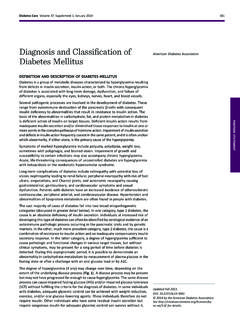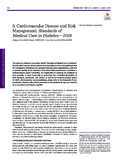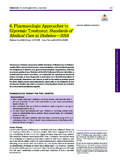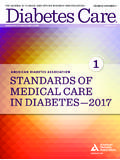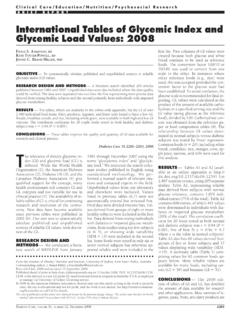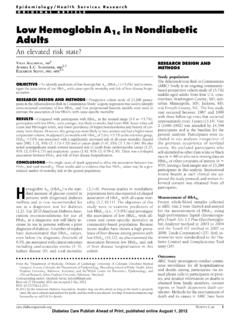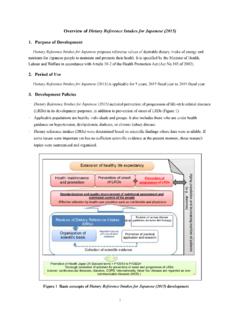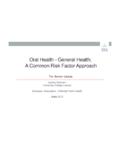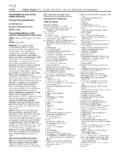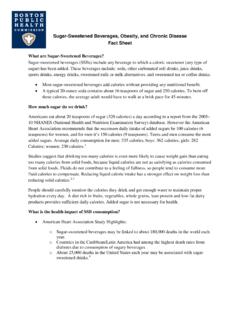Transcription of 1 Nutrition Therapy Recommendations for the …
1 Nutrition TherapyRecommendations for theManagement of Adults WithDiabetesA healthful eating pattern, regular physical activity, and often pharmacotherapyare key components of diabetes management. For many individuals withdiabetes, the most challenging part of the treatment plan is determining what toeat. It is the position of the American Diabetes Association (ADA) that there isnot a one-size-fits-all eating pattern for individuals with diabetes. The ADA alsorecognizes the integral role of nutritiontherapy in overall diabetes managementand has historically recommended that eachpersonwithdiabetesbeactivelyengaged in self-management, education,and treatment planning with his or herhealth care provider, which includes the collaborative development of anindividualized eating plan (1,2). Therefore, it is important that all members of thehealth care team be knowledgeable aboutdiabetes Nutrition Therapy and supportits position statement on Nutrition Therapy for individuals living with diabetesreplaces previous position statements,the last of which was published in 2008(3).
2 Unless otherwise noted, research reviewed was limited to those studiesconducted in adults diagnosed with type 1 or type 2 diabetes. Nutritiontherapy for the prevention of type 2 diabetes and for the management ofdiabetes complications and gestational diabetes mellitus is not addressed in grading system, developed by the ADA and modeled after existing methods, wasutilized to clarify and codify the evidence that forms the basis for therecommendations (1) (Table 1). The level of evidence that supports eachrecommendation is listed after the recommendation using the lettersA,B,C, table linking Recommendations toevidence can be reviewed at of the Nutrition RecommendationsWriting Group Committee disclosed all potentialfinancial conflicts of interest withindustry. These disclosures were discussed at the onset of the position statementdevelopment process. Members of this committee, their employers, and theirdisclosed conflicts of interest are listed in theACKNOWLEDGMENTS. The ADA usesgeneral revenues to fund development of its position statements and does not relyon industry support for these OF Nutrition Therapy THAT APPLY TO ADULTS WITH DIABETES To promote and support healthful eating patterns, emphasizing a variety ofnutrient dense foods in appropriate portion sizes, in order to improve overallhealth and specifically to:cAttain individualized glycemic, blood pressure, and lipid goals.
3 Generalrecommended goals from the ADA for these markers are as follows:*cA1C,7%.cBlood pressure,140/80 cholesterol,100 mg/dL; triglycerides,150 mg/dL; HDL for men; HDL mg/dL for and maintain body weight or prevent complications of of Washington Medical Center,Seattle, WA2 Minneapolis Heart Institute Foundation,Minneapolis, MN3 Department of Endocrinology, ABQ HealthPartners, Albuquerque, NM4 American Diabetes Association, Alexandria, VA5 Nutrition Concepts by Franz, Minneapolis, MN6 Gillings School of Global Public Health andSchool of Medicine, University of North Carolinaat Chapel Hill, Chapel Hill, NC7 Department of Pharmacotherapy, WashingtonState University, Spokane, WA8 University of Michigan Medical School and theCenter for Preventive Medicine, Ann Arbor, MI9pbu consulting, llc., Cloquet, MN10 Duke University School of Medicine, Durhum, NCCorresponding authors: Alison B. Evert, and Jackie L. 2014 by the American Diabetes for B. Evert, MS, RD, CDE;1 Jackie L.
4 Boucher, MS, RD, LD, CDE;2 Marjorie Cypress, PhD, C-ANP, CDE;3 Stephanie A. Dunbar, MPH, RD;4 Marion J. Franz, MS, RD, CDE;5 Elizabeth J. Mayer-Davis, PhD, RD;6 Joshua J. Neumiller, PharmD, CDE, CGP,FASCP;7 Robin Nwankwo, MPH, RD, CDE;8 Cassandra L. Verdi, MPH, RD;4 Patti Urbanski, MEd, RD, LD, CDE;9andWilliam S. Yancy Jr., MD, MHSC10S120 Diabetes CareVolume 37, Supplement 1, January 2014 POSITION STATEMENTT able 1 Nutrition Therapy recommendationsTopicRecommendationEviden ce ratingEffectiveness of Nutrition therapyNutrition Therapy is recommended for all people with type 1 and type 2 diabetes as aneffective component of the overall treatment who have diabetes should receive individualized MNT as needed to achievetreatment goals, preferably provided by an RD familiar with the components ofdiabetes individuals with type 1 diabetes, participation in an intensiveflexible insulintherapy education program using the carbohydrate counting meal planningapproach can result in improved glycemic individuals usingfixed daily insulin doses.
5 Consistent carbohydrate intakewith respect to time and amount can result in improved glycemic control andreduce risk for simple diabetes meal planning approach such as portion control or healthfulfood choices may be better suited to individuals with type 2 diabetes identifiedwith health and numeracy literacy concerns. This may also be an effective mealplanning strategy for older with diabetes should receive DSME according to national standards anddiabetes self-management support when their diabetes is diagnosed and as diabetes Nutrition Therapy can result in cost savingsBand improvedoutcomes such as reduction in A1CA, Nutrition Therapy should be adequatelyreimbursed by insurance and other ,A,EEnergy balanceFor overweight or obese adults with type 2 diabetes, reducing energy intake whilemaintaining a healthful eating pattern is recommended to promote weight weight loss may provide clinical benefits (improved glycemia, blood pressure,and/or lipids) in some individuals with diabetes, especially those early in the diseaseprocess.
6 To achieve modest weight loss, intensive lifestyle interventions (counselingabout Nutrition Therapy , physical activity, and behavior change) with ongoingsupport are mix of macronutrientsEvidence suggests that there is not an ideal percentage of calories from carbohydrate ,protein, and fat for all people with diabetesB; therefore, macronutrient distributionshould be based on individualized assessment of current eating patterns,preferences, and metabolic ,EEating patternsA variety of eating patterns (combinations of different foods or food groups) areacceptable for the management of diabetes. Personal preferences ( , tradition,culture, religion, health beliefs and goals, economics) and metabolic goals should beconsidered when recommending one eating pattern over is inconclusive for an ideal amount of carbohydrate intake for people withdiabetes. Therefore, collaborative goals should be developed with the individualwith amount of carbohydrates and available insulin may be the most important factorinfluencing glycemic response after eating and should be considered whendeveloping the eating carbohydrate intake , whether by carbohydrate counting or experience-based estimation remains a key strategy in achieving glycemic good health, carbohydrate intake from vegetables, fruits, whole grains, legumes,and dairy products should be advised over intake from other carbohydrate sources,especially those that contain added fats, sugars.
7 Or index and glycemic loadSubstituting low-glycemic load foods for higher-glycemic load foods may modestlyimprove glycemic and whole grainsPeople with diabetes should consume at least the amount offiber and whole grainsrecommended for the general of sucrose for starchWhile substituting sucrose-containing foods for isocaloric amounts of othercarbohydrates may have similar blood glucose effects, consumption should beminimized to avoid displacing nutrient-dense food consumed as free fructose ( , naturally occurring in foods such as fruit)may result in better glycemic control compared with isocaloric intake of sucrose orstarchB, and free fructose is not likely to have detrimental effects on triglycerides aslong as intake is not excessive (.12% energy).CB,CPeople with diabetes should limit or avoid intake of SSBs (from any caloric sweetenerincluding high fructose corn syrup and sucrose) to reduce risk for weight gain andworsening of cardiometabolic risk on p. Statement S121 Table 1 ContinuedTopicRecommendationEvidence ratingNNSs and hypocaloric sweetenersUse of NNSs has the potential to reduce overall calorie and carbohydrate intake ifsubstituted for caloric sweeteners without compensation by intake of additionalcalories from other food people with diabetes and no evidence of diabetic kidney disease, evidence isinconclusive to recommend an ideal amount of protein intake for optimizingglycemic control or improving one or more CVD risk measures; therefore, goalsshould be people with diabetes and diabetic kidney disease (either micro- ormacroalbuminuria), reducing the amount of dietary protein below usual intake isnot recommended because it does not alter glycemic measures, cardiovascular riskmeasures, or the course of GFR individuals with type 2 diabetes, ingested protein appears to increase insulinresponse without increasing plasma glucose concentrations.
8 Therefore, carbohydrate sources high in protein should not be used to treat or fatEvidence is inconclusive for an ideal amount of total fat intake for people withdiabetes; therefore, goals should be quality appears to be farmore important than ,BMUFAs/PUFAsIn people with type 2 diabetes, a Mediterranean-style, MUFA-rich eating pattern maybenefit glycemic control and CVD risk factors and can therefore be recommended asan effective alternative to a lower-fat, higher- carbohydrate eating fatty acidsEvidence does not support recommending omega-3 (EPA and DHA) supplements forpeople with diabetes for the prevention or treatment of cardiovascular recommended for the general public, an increase in foods containing long-chainomega-3 fatty acids (EPA and DHA) (from fattyfish) and omega-3 linolenic acid (ALA)is recommended for individuals with diabetes because of their beneficial effects onlipoproteins, prevention of heart disease, and associations with positive healthoutcomes in observational recommendation for the general public to eatfish (particularly fattyfish) at leasttwo times (two servings)
9 Per week is also appropriate for people with fat, dietary cholesterol, andtransfatThe amount of dietary saturated fat, cholesterol, andtransfat recommended forpeople with diabetes is the same as that recommended for the general stanols and sterolsIndividuals with diabetes and dyslipidemia may be able to modestly reduce total andLDL cholesterol by consuming 3 g/day of plant stanols or sterols typically foundin enriched and herbal supplements There is no clear evidence of benefit from vitamin or mineral supplementation inpeople with diabetes who do not have underlying supplementation with antioxidants, such as vitamins E and C andcarotene, is not advised because of lack of evidence of efficacy and concernrelated to long-term is insufficient evidence to support the routine use of micronutrients such aschromium, magnesium, and vitamin D to improve glycemic control in people is insufficient evidence to support the use of cinnamon or other herbs/supplements for the treatment of is recommended that individualized meal planning include optimization of foodchoices to meet recommended dietary allowance/dietary reference intake for adults with diabetes choose to drink alcohol, they should be advised to do so inmoderation (one drink per day or less for adult women and two drinks per day orless for adult men).
10 EAlcohol consumption may place people with diabetes at increased risk for delayedhypoglycemia, especially if taking insulin or insulin secretagogues. Education andawareness regarding the recognition and management of delayed hypoglycemia recommendation for the general population to reduce sodium to less than 2,300mg/day is also appropriate for people with individuals with both diabetes and hypertension, further reduction in sodiumintake should be Position StatementDiabetes CareVolume 37, Supplement 1, January 2014 To address individual Nutrition needsbased on personal and culturalpreferences, health literacy andnumeracy, access to healthful foodchoices, willingness and ability tomake behavioral changes, as well asbarriers to change. To maintain the pleasure of eating byproviding positive messages aboutfood choices while limiting foodchoices only when indicated byscientific evidence. To provide the individual with diabeteswith practical tools for day-to-daymeal planning rather than focusing onindividual macronutrients,micronutrients, or single foods.

